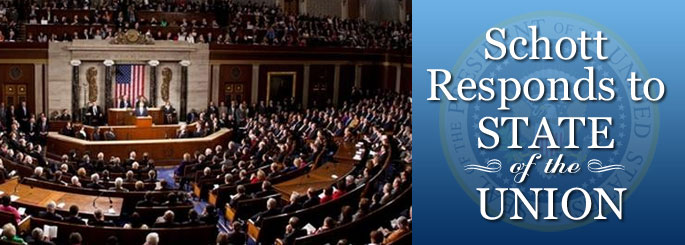Press Release
The Commander-in-Chief — and the Battle for Public Education

During President Obama’s third State of the Union Address, he rightfully urged the leadership in Congress, and the American people, to use the same collaborative approach to solve our domestic issues that the military uses to address our international threats. We agree with the President that employing these values can help solve many of our domestic challenges-starting with education. In fact, for over a decade the Department of Defense schools have been one of the highest performing and most equitable systems of public education in our nation.
THE MILITARY MODEL
As Michael Winerip recently reported in the New York Times, the k-12 schools run by the Department of Defense are effective because the federal government went beyond inspiration and took steps to ensure that all soldiers, regardless of rank or base location, could send their children to the same well-equipped schools. (Nearly all of the 69 military base schools are in the South. They were opened in the 1950s and ’60s because the military was racially integrated and did not want the children of Black soldiers to attend racially segregated schools off base.) The military also ensured that soldiers were not living in extreme poverty and that community supports were in place to meet their families’ needs.
As a result, the most recent National Assessment of Educational Progress (NAEP) data revealed that, once again, schools on the nation’s military bases outperformed other public schools in both reading and math for fourth and eighth graders. Furthermore, the achievement gap between black and white students is significantly smaller at military base schools and is decreasing faster than at traditional public schools or charters. We encourage the President to look to this military model and not to leave performance and equity as an inspirational challenge with very little support and federal engagement to help states and cities achieve this goal. The President must be intentional about creating the conditions by which all students, regardless of where they are born, have an opportunity to learn.
A COMPREHENSIVE APPROACH IS REQUIRED
As Winerip reported, the military also recognizes that “Helping children succeed academically is about a lot more than what goes on inside the schools… The average class in New York City in kindergarten through the third grade has 24 students. At military base schools, the average is 18. Military parents do not have to worry about securing health care coverage for their children or adequate housing. At least one parent in the family has a job.” The Broader, Bolder campaign has advocated this approach for years.
SUPPORTING TEACHERS IS A NECESSITY
As the President rightfully noted, teachers are “nation builders,” one of our nation’s most precious commodities. Just as the military has developed serious steps around the recruitment, retention, and continued training of its soldiers, we should also take serious steps to ensure the recruitment of well-prepared public school teachers, the supports to retain them, and the continual training and opportunities for group collaboration to constantly develop them. This is a far cry away from the “evaluate and fire” approach being proposed too often in city, state and federal legislation today.
AN EDUCATION SURGE IS NEEDED
The American dream is not out of reach for our children but it will take a serious execution of our values for them to reach it. As the Schott Foundation 2020 Vision Roadmap report revealed, America will need to retain an additional 5.7 million above the 2.9 million projected students in the secondary graduation pipeline to achieve the nation’s goal of being a global leader in postsecondary attainment by 2020. Therefore, the President is right in calling for the equivalent of a military surge-requiring that students remain in the education pipeline until graduation or age 18-but a surge that doesn’t provide the troops with the tools needed to be successful is both bad strategy and immoral. Will this surge increase the number of students forced to stay in dilapidated or “warehouse” schools, or will we invest to keep students in well-equipped, twenty-first century public schools? Will we require that students remain in school, but not require that schools avoid pushing them out through racially disparate suspension and expulsion policies?
If America is going to be open for business for the world, it must lead by example and open a world of opportunity for all students in America-by giving them substantive access to our system of higher education and the training in our community colleges or “community career centers.” This is particularly necessary in southern and midwestern states where needed economic and job growth is lagging the most. Fair trade agreements do not end only with products, but include giving all students in America a fair and substantive opportunity to learn so they can be competitive in the global economy.
FUNDING THE BATTLE
This surge will require us to ensure we are allocating existing resources in the areas that give us the best chance of winning, like early childhood education, and professional development, and other supports for teachers. It will also require that we make tough decisions on revenue reform to yield additional resources. We must decide if the battle to save our young people will be waged in penal institutions or will start with early education; and, if our decision is early education, as it should be, we must change policies that lead to increased numbers of incarcerated youth and growth in spending for penal institutions, often at the expense of education. In addition to challenging colleges and universities to reduce tuition costs, we urge the President to challenge states to reduce youth incarceration rates, cut spending on penal institutions, and put those savings into education.
Finally, to win this battle and support the needed surge, we will definitely need to generate new revenue sources. We support the President’s call for fair tax systems. Several of our grantees, like the Massachusetts Budget and Policy Center, New York’s Alliance for Quality Education, and the national Alliance for Educational Justice have been leading advocates for this work across the nation.
BATTLE PLAN: OPPORTUNITY TO LEARN AGENDA
Understanding that we are starting this battle at a point where, across the nation, millions of students are behind, we urge the President to lay out a plan for states to restore those students who we have already left behind by giving them each an Opportunity Plan. These individual plans would give them access to additional academic supports – like tutoring and extended day learning; social supports like mentors; and health checks for vision, dental and mental health-needed to succeed. To create the type of systemic reform that we see on our military bases, President Obama must ensure that all students have access to high quality early education and college preparatory curricula, and that all schools have equitable resources and can recruit and retain highly effective teachers.
Reform requires commanding leadership – not lowest common denominator, politically expedient compromises to chart our nation’s education course. This agenda can’t be dropped on states’ doorsteps with only words of encouragement. States can’t be allowed to charter a course away from reform, vouch to it, or be waived of the obligation to achieve it, but must instead be supported and held accountable for reaching our national goal. We urge the President to not only seize his role as Commander-in-Chief of the military in the battle against foreign threats, but as Commander-in-Chief in the battle to save our next generation. Don’t leave the public education battle for market forces to fight-that only leaves our children and our nation wounded. Simply stated, the challenges to the economic, job, fair trade, and immigration state of our union can be solved by providing an opportunity to learn for each student in every state of our union.


